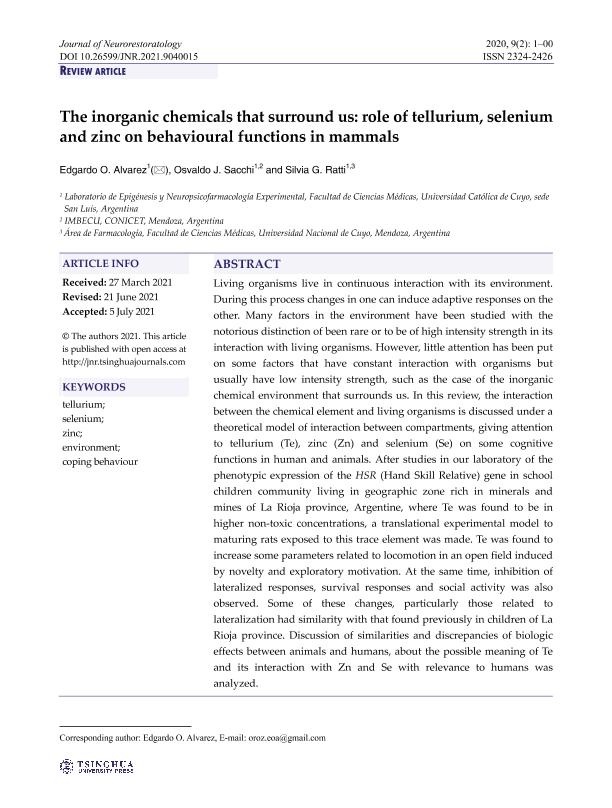Mostrar el registro sencillo del ítem
dc.contributor.author
Alvarez, Edgardo Oscar

dc.contributor.author
Sacchi, Osvaldo Jorge

dc.contributor.author
Ratti, Silvia Gabriela

dc.date.available
2022-10-06T18:45:35Z
dc.date.issued
2021-07
dc.identifier.citation
Alvarez, Edgardo Oscar; Sacchi, Osvaldo Jorge; Ratti, Silvia Gabriela; The inorganic chemicals that surround us: role of tellurium, selenium and zinc on behavioural functions in mammals; Tsinnghua University Press; Journal of Neurorestoratology; 9; 2; 7-2021; 1-13
dc.identifier.issn
2324-2426
dc.identifier.uri
http://hdl.handle.net/11336/172320
dc.description.abstract
Living organisms live in continuous interaction with its environment.During this process changes in one can induce adaptive responses on theother. Many factors in the environment have been studied with thenotorious distinction of been rare or to be of high intensity strength in itsinteraction with living organisms. However, little attention has been puton some factors that have constant interaction with organisms butusually have low intensity strength, such as the case of the inorganicchemical environment that surrounds us. In this review, the interactionbetween the chemical element and living organisms is discussed under atheoretical model of interaction between compartments, giving attentionto tellurium (Te), zinc (Zn) and selenium (Se) on some cognitivefunctions in human and animals. After studies in our laboratory of thephenotypic expression of the HSR (Hand Skill Relative) gene in schoolchildren community living in geographic zone rich in minerals andmines of La Rioja province, Argentine, where Te was found to be inhigher non‐toxic concentrations, a translational experimental model tomaturing rats exposed to this trace element was made. Te was found toincrease some parameters related to locomotion in an open field inducedby novelty and exploratory motivation. At the same time, inhibition oflateralized responses, survival responses and social activity was alsoobserved. Some of these changes, particularly those related tolateralization had similarity with that found previously in children of LaRioja province. Discussion of similarities and discrepancies of biologiceffects between animals and humans, about the possible meaning of Teand its interaction with Zn and Se with relevance to humans wasanalyzed.
dc.format
application/pdf
dc.language.iso
eng
dc.publisher
Tsinnghua University Press
dc.rights
info:eu-repo/semantics/openAccess
dc.rights.uri
https://creativecommons.org/licenses/by-nc/2.5/ar/
dc.subject
TELLURIUM
dc.subject
SELENIUM
dc.subject
ZINC
dc.subject.classification
Otras Ciencias de la Salud

dc.subject.classification
Ciencias de la Salud

dc.subject.classification
CIENCIAS MÉDICAS Y DE LA SALUD

dc.title
The inorganic chemicals that surround us: role of tellurium, selenium and zinc on behavioural functions in mammals
dc.type
info:eu-repo/semantics/article
dc.type
info:ar-repo/semantics/artículo
dc.type
info:eu-repo/semantics/publishedVersion
dc.date.updated
2022-09-20T17:57:57Z
dc.journal.volume
9
dc.journal.number
2
dc.journal.pagination
1-13
dc.journal.pais
China

dc.journal.ciudad
Pekín
dc.description.fil
Fil: Alvarez, Edgardo Oscar. Universidad Catolica de Cuyo. Sede San Luis. Facultad de Ciencias Medicas. Laboratorio de Epigenesis y Neuropsicofarmacologia Experimental; Argentina
dc.description.fil
Fil: Sacchi, Osvaldo Jorge. Consejo Nacional de Investigaciones Científicas y Técnicas. Centro Científico Tecnológico Conicet - Mendoza. Instituto de Medicina y Biología Experimental de Cuyo; Argentina. Universidad Catolica de Cuyo. Sede San Luis. Facultad de Ciencias Medicas. Laboratorio de Epigenesis y Neuropsicofarmacologia Experimental; Argentina
dc.description.fil
Fil: Ratti, Silvia Gabriela. Universidad Catolica de Cuyo. Sede San Luis. Facultad de Ciencias Medicas. Laboratorio de Epigenesis y Neuropsicofarmacologia Experimental; Argentina
dc.journal.title
Journal of Neurorestoratology
dc.relation.alternativeid
info:eu-repo/semantics/altIdentifier/url/https://www.sciencedirect.com/science/article/pii/S2324242622000511
dc.relation.alternativeid
info:eu-repo/semantics/altIdentifier/doi/http://dx.doi.org/10.26599/JNR.2021.9040015
Archivos asociados
